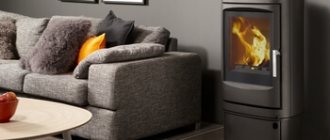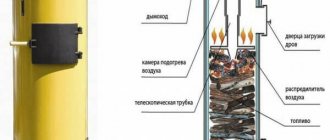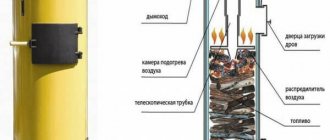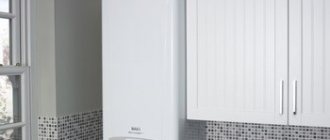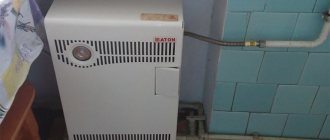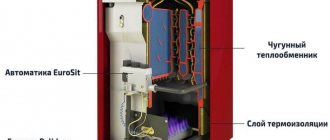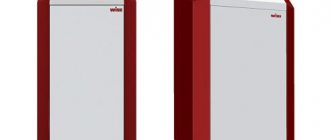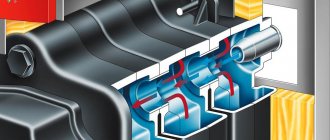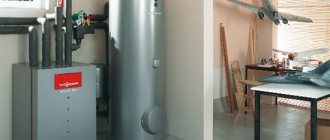A long-burning solid fuel boiler (TCDG) can be a good source of heat in a private house or cottage.
It can operate for a long time on one load of fuel, which is facilitated by the special technology introduced into it.
To make an informed choice in favor of a particular model, you need to take into account many nuances.
To make your choice easier, we have compiled a rating of solid fuel boilers. According to buyers of 2021-2022, all models included in it have an optimal price/quality ratio, ease of operation and attractive appearance.
Rating of the TOP 15 best long-burning solid fuel boilers for 2021-2022
| Place | Name | Price |
| TOP 4 best long-burning solid fuel boilers in price/quality ratio for 2021-2022 | ||
| 1 | Teplodar Kupper Expert-15 single-circuit | Find out the price |
| 2 | ZOTA Topol-16VK 16 kW single-circuit | Find out the price |
| 3 | Teplodar Kupper Expert-22 single-circuit | Find out the price |
| 4 | ZOTA Topol32VK 32 kW, single-circuit | Find out the price |
| TOP 4 best long-burning solid fuel boilers with a water circuit | ||
| 1 | Bourgeois-K STANDARD-10 10 kW single-circuit | Find out the price |
| 2 | Bourgeois-K STANDARD-20 20 kW single-circuit | Find out the price |
| 3 | Bourgeois-K STANDARD-30 30 kW single-circuit | Find out the price |
| 4 | Bourgeois-K MODERN-32 32 kW single-circuit | Find out the price |
| TOP 4 best long-burning solid fuel boilers with wood | ||
| 1 | ZOTA Topol-22VK 22 kW single-circuit | Find out the price |
| 2 | Teplodar Kupper Expert-45 single-circuit | Find out the price |
| 3 | ZOTA Lava 26 26 kW, single-circuit | Find out the price |
| 4 | Teplodar Kupper Expert-30 30 kW, single-circuit | Find out the price |
| TOP 3 best long-burning solid fuel boilers using pellets | ||
| 1 | ZOTA Stakhanov 63 (left) 63 kW, single-circuit | Find out the price |
| 2 | TermoKRoss TKR-15P1 single-circuit | Find out the price |
| 3 | ZOTA Stakhanov 15 (left) 15 kW single-circuit | Find out the price |
Boilers
Boilers
– these are devices designed for heating buildings and structures for various purposes: individual and apartment buildings, cottages, industrial facilities, production workshops, garages, etc.
The variety of areas of use of universal devices requires a wide range of powers: from 10 to 1000 kW. Their operating principle is based on the combustion of various types of fuel. According to this criterion, they are divided into - solid fuel, burning wood, coal, briquettes, etc.; - pellet; — gas; — diesel; — electric; - combined. In addition, depending on the functional features, boiler units can be single-circuit - focused only on heating; - double-circuit - heating + provision of hot water supply. Depending on the installation method, boilers can be wall-mounted or floor-mounted. The full catalog of domestic and foreign equipment can be found on our website Magazin-Pechi.ru.
The Furnace Shop company is actively engaged in the development of the “Boiler Equipment” direction. Since 2012, it has become clear that our customers are not only interested in the opportunity to purchase heating boilers, they are interested in a whole range of services. We sell wood boilers, coal boilers, pellet boilers, we carry out chimney installation, turnkey heating installation. That is why we have created our own HVAC Installation Department, whose specialists are always happy to help you.
Solid fuel boiler: how to choose
An important advantage of such boilers is sometimes their energy independence, when the design does not contain devices that require power supply, even mechanical thermostats. More often this concerns domestic manufacturers, who are familiar first-hand with power outages in rural areas and take this fact into account in boiler designs. However, we should not forget that modern heating systems, even with a solid fuel boiler as a heat source, work more stably in the presence of a circulation pump, and it does not work without power supply, alas.. So, in case of problems with light, it is still recommended to acquire a backup power supply station, but often a solid fuel boiler is excluded from the list of energy-consuming devices.
Solid fuel boiler heat exchanger material: cast iron or steel
Cast iron solid fuel boiler
A solid fuel boiler is associated with something bulky and heavy, since its heat exchanger is often made of cast iron. Boiler manufacturers use this material for its durability, high corrosion resistance (wear of a cast iron heat exchanger under normal conditions is 0.1-0.2 mm per year, so with a wall thickness of 5 mm it will last for twenty years), resistance to high temperatures ( when burning coal, only a cast iron heat exchanger can withstand a combustion temperature of 900 degrees C), temperature deformations are not typical for it.
The disadvantages of boilers with cast iron heat exchangers include their heavy weight, which makes transportation difficult, during which the equipment must not be dropped or hit - cast iron is fragile and cracks with a sharp impact. Cracks will also appear if cold water is spilled on a hot heat exchanger or if the boiler is fed with too cold water. A difference between the supply and return temperatures of more than 50 degrees C can be detrimental to a cast iron heat exchanger, even if microcracks are not visually visible at first. Some modern products made of eutectic (elastic) cast iron work successfully with low temperatures at the boiler inlet; it exceeds ordinary gray cast iron in elasticity by an average of 30% and this makes it possible for the boiler to operate in low-temperature mode.
Another solution for low-temperature operation of solid fuel boilers can be the use of a buffer tank in the boiler circuit.
At the same time, cast iron heat exchangers consist of sections and therefore are subject to repair - sections are replaced, fastened with screws with a heat-resistant gasket and sealant. Thanks to its sectional design, a cast iron boiler can “grow” with the house. For example, having attached a large workshop or greenhouse to your house, you can not buy an additional boiler, but only add internal sections, thereby increasing the boiler power to the required one.
The power of a household boiler is calculated using the formula “1 kW per 10 m² of heated area”, that is, for a house of 200 m² you will need a boiler with a capacity of 20 kW.
Steel solid fuel boiler
Boilers with steel heat exchangers are selected similarly in terms of power, but their designs are more varied and they are usually cheaper, which makes them a common source of heat in solid fuel boiler houses.
The lightness of the steel heat exchanger and its welded construction are both advantages and disadvantages of a solid fuel boiler. Transporting and unloading is easier, however, such a boiler also tolerates temperature extremes less well; if overheated, the heat exchanger can become deformed, the welds can leak, and sometimes the wall of the heat exchanger can burn out.
Most often, such situations arise during an emergency power outage and in systems with forced circulation. In this case, the boiler continues to fire, but the circulation pump does not rotate, does not remove heat from the boiler, and overheating occurs. Uninterruptible power supplies help, but in 50% of cases they do not work; it is best if there is an automatic switch to a diesel power plant. The most effective way to protect a solid fuel boiler from overheating in the event of an accident on the electrical grid is considered to be a short circuit with gravitational circulation provided during construction, that is, a section of large-diameter pipes where the coolant heated by the boiler will be located during the accident.
What burns in a solid fuel boiler?
Coal:
Brown, black or anthracite - these three types of coal contain the amount of energy required to heat the coolant, brown - the least, anthracite - the greatest. Most often, black coal is used as fuel. In general, coal combustion is approximately three times more efficient than wood burning; when burned, it emits from 5000 to 8000 kcal/kg, while firewood produces from 1500 to 2500. This is a plus for coal combustion. However, storing coal requires a special room, coal emits coal dust, often contains impurities that reduce its efficiency when burned, it is not easy to ignite, and when poured into a layer half the thickness of the firebox, it may not burn, but sinter on the grate.
Coal combustion requires the constant presence of maintenance personnel, and this must be taken into account when choosing a boiler with such a fuel source. A boiler with automatic coal supply can solve this issue.
Peat:
Peat briquettes can be used as a heat source in the same boilers where coal and wood can be burned in an open way. The calorific value of peat is quite low. When they are burned, they produce smoke with an unpleasant odor, a lot of ash, and during storage they crumble, impairing combustion efficiency, but if no other sources are found, peat can be used. Without the participation of a fireman, such boilers operate in an industrial version, on milled peat with a screw feed, a drying chamber, and in this form the power of the boiler room can reach 10 MW
Tree:
In regions with large areas of wild forests, firewood becomes the most economical and easily accessible fuel for boilers.
You can fuel a boiler with apple, cherry, or pear trees, and the calorific value of such firewood is quite high, but it is difficult to find them in large quantities, and the logs do not split well and are knotty and do not fit tightly into the firebox. Poplar firewood burns quickly and hotly, but there is little heat from it, its wood is not dense.
Firewood for the boiler should have a moisture content of no more than 15-25%, so they should not be used immediately after cutting; a place should be provided for their storage and it is better to burn it with firewood that has dried naturally for 2-3 years, or after forced drying.
Boiler fireboxes, depending on the power, allow the use of log lengths of up to 70-80 cm, although the most common size is 25-40 cm. The firebox is loaded with firewood approximately halfway at once, ignited and then logs are added as needed. During the burning process, the logs must be turned several times, giving additional air access for uniform combustion. All solid fuel boilers do not operate without air flow, so the room for them should be ventilated, and the chimney for better draft should be installed at a long length - 6-7 m
Firewood: pyrolysis combustion method
To increase the time interval between adding firewood to the boiler, which is especially important at night in the winter, as well as to reduce the cost of maintaining a stoker, engineers have created and successfully used boilers with the pyrolysis method of burning wood. Unlike the direct method, when the heat from burning wood is only partially spent on heating the coolant, but mostly flies out into the chimney, during pyrolysis the gas released during the combustion of wood is burned.
A two-chamber fuel combustion system makes it possible to achieve a boiler efficiency of 85-90%, and although this combustion method is acceptable for both coal and peat, it is when dry wood with no more than 20% moisture content is used that it is most effective. The time for laying wood of both soft and hard varieties in such a boiler is 5-6 hours, and under good conditions: dry fuel, stable air supply to the combustion chamber, proper thermal insulation of the house can be 10 hours. When using wet wood, a large amount of water vapor, and this is fraught with the formation of soot and tar, poor thermal conductivity of the boiler or its attenuation. With the correct course of the pyrolysis process, the firewood burns practically without ash, the smoke from the chimney is colorless, and the coolant quickly heats up to the optimal 60 degrees C.
There are also boilers of combined action, when 80% of the wood is burned in pyrolysis mode, and 20% in the mode of a conventional solid fuel boiler.
The disadvantages of pyrolysis boilers include their high cost compared to conventional solid fuel boilers, increased requirements for dry wood, the lack of automatic fuel supply, and operation only in heating mode; such boilers are not double-circuit.
Pellets and wood waste:
Not a single major European construction exhibition of boiler equipment is complete without a demonstration of equipment running on pellets - wood fuel pellets. Such fuel began to be used in the 80s of the twentieth century, and now boilers for working with it are in the line of almost all leading manufacturers of solid fuel boilers. Automation of the process of loading fuel into the combustion chamber, low humidity and, accordingly, high heat capacity of pellets, coupled with small dimensions for storage and transportation, makes them very convenient and efficient, especially in areas where woodworking is developed. When burning Premium grade pellets, no more than 1% of ash is formed, while Standard grade pellets produce no more than 3%, so this fuel is also very environmentally friendly.
Wood chips, bark and sawdust have long been used as fuel in boiler houses, but to use them effectively, you should choose boilers of a specific design, they have a layered combustion chamber, a rotating grate or other parts and techniques that allow complete combustion of both coarse wood, wood chips, and dispersive, like sawdust. Most often, such boilers are used in industrial boiler houses.
Modern solid fuel boilers include thermostats, boost fans, control devices and, if desired, they can be used to build a convenient, comfortable boiler room in areas where there is no gas supply. Such boilers are cheaper than electric boilers to operate and can often operate as non-volatile devices.
Boilers in the online store ➦ Stoves store. ☎: +7(495) 902-57-82. ✔️ Sandwich Chimneys 1mm thick from the manufacturer. Low prices. High quality. Delivery across Russia.
To order the installation and installation of a chimney for a bathhouse, cottage, or home, CALL ☎.
Which long-burning solid fuel boiler to choose for heating a private home or cottage?
When choosing a TKDG in 2021-2022, it is important to pay attention to such characteristics as:
- Fuel type . The devices can be designed for a specific fuel or be universal. The options used are coal, peat, firewood.
- Device power . For domestic needs it is not higher than 100 kW.
- Number of circuits : double-circuit or single-circuit.
- Camera size . The operating time of the equipment depends on it.
- Economical . The main indicator is efficiency.
Tips for choosing
- It is worth installing a boiler for which it is easier and cheaper to buy fuel. If coal or firewood is cheaper in the installation region, you should give preference to equipment using such fuel. If at certain times of the year one type of fuel is cheaper (for example, coal), and at other times another fuel is cheaper (for example, peat), then you should choose a universal boiler that uses different types of fuel.
A very effective universal heater is a device with a combination of the ability to operate on solid fuel and gas.
- If there is always a person in the house who can regularly add fuel to the boiler, then it is better to choose the classic option.
- To heat a large room, it is better to install a more advanced model - pyrolysis or long-burning.
- For constant use, a cast iron device is better suited; for use as an additional heater, it is worth installing a steel version.
- For heating and hot water supply, you should purchase a double-circuit version or a set of single-circuit and indirect heating boiler.
Which company should you choose?
Models from the following manufacturers are sold on the Russian market:
- Teplodar . Produces small-sized equipment.
- Stropuva . Manufacturer from Lithuania, producing TKDG.
- ZOTA . It produces equipment with power from 3 to 300 kW.
- NMK . Produces boilers Sibir, Magnum, Atum.
- TeploGarant . Leading brand of boiler equipment.
- Vesuvius . It produces equipment made of cast iron; the products are easy to use and do not require basic maintenance skills.
Manufacturers rating
The quality and performance characteristics of heating equipment largely depend on the brand. Serious companies value their reputation and produce equipment of excellent quality. The most reliable boiler manufacturers are the following companies:
- Buderus is a German manufacturer of heating equipment. It produces products of various types and capacities. The company was founded in 1731 and is still in operation, which speaks volumes about the quality of its products.
- Kentatsu is a Japanese company with a century and a half history. The largest manufacturer of climate control equipment. A distinctive feature of boilers of this brand is reliability and durability.
- Lemax is a Russian manufacturer of heating equipment from Taganrog. Due to high reliability and affordable prices, the company's products are in great demand.
- ZOTA is a Russian brand. Produces a wide range of heating equipment of various capacities. Solid fuel units are made of steel. There are no cast iron models in the line.
- Teplodar is a well-established brand of Russian heating equipment. The line of manufactured equipment is not very wide, but the quality of the products is not inferior to the best world companies.
24-hour loss of thermal energy
To maintain the required temperature in the house, the solid fuel boiler must operate 24 hours a day. Now imagine how much useful heat flies out into the chimney in the form of soot and unburned gases during this time? The efficiency of such work cannot be 90%.
Another type of boiler worth mentioning here is the pyrolysis boiler. In addition to the above disadvantages, two more are added in his case:
- A fan running 24/7 consumes electricity.
- Thanks to the same fan, excess oxygen enters the boiler - the temperature of the gases decreases, they do not have time to burn and fly away into the chimney.
The accelerated movement of gases through the pipe causes a decrease in another parameter - heat transfer efficiency. Due to the special design of the boiler, the flame in it does not have time to burn out and rises into the heat exchanger, where it dies out, leaving soot along the way and throwing unburned gases into the chimney.
How to increase the efficiency of heating equipment running on solid fuels
*
Today, many consumers, having at their disposal a solid fuel boiler, are trying to find the most convenient and practical way to increase the efficiency of heating equipment. The technological parameters of heating devices set by the manufacturer lose their nominal values over time, so various methods and means are being sought to increase the efficiency of boiler equipment.
Let's consider one of the most effective options, installing an additional heat exchanger. The task of the new equipment is to remove thermal energy from volatile combustion products.
In the video you can see how to make your own economizer (heat exchanger)
To do this, we first need to know what the temperature of the smoke at the outlet is. You can change it using a multimeter, which is placed directly in the middle of the chimney. Data on how much additional heat can be obtained from evaporating combustion products is necessary to calculate the area of the additional heat exchanger. We do the following:
- we send a certain amount of firewood into the firebox;
- We measure how long it takes for a certain amount of firewood to burn.
For example: firewood, in the amount of 14.2 kg. burn for 3.5 hours. The smoke temperature at the boiler outlet is 460 0 C.
In 1 hour we burned: 14.2/3.5 = 4.05 kg. firewood
To calculate the amount of smoke, we use the generally accepted value of 1 kg. firewood = 5.7 kg. flue gases. Next, we multiply the amount of wood burned in one hour by the amount of smoke produced by burning 1 kg. firewood As a result: 4.05 x 5.7 = 23.08 kg. volatile combustion products. This figure will become the starting point for subsequent calculations of the amount of thermal energy that can be additionally used to heat the second heat exchanger.
Knowing the value of the heat capacity of volatile hot gases as 1.1 kJ/kg, we make a further calculation of the heat flow power if we want to reduce the smoke temperature from 460 0C to 160 degrees.
Q = 23.08 x 1.1 (460-160) = 8124 kJ thermal energy.
As a result, we obtain the exact value of the additional power provided by volatile combustion products: q = 8124/3600 = 2.25 kW, a large figure that can have a significant impact on increasing the efficiency of heating equipment. Knowing how much energy is wasted, the desire to equip the boiler with an additional heat exchanger is completely justified. Due to the influx of additional thermal energy for heating the coolant, not only the efficiency of the entire heating system increases, but also the efficiency of the heating unit itself increases.
Why you shouldn't trust advertising
When viewing advertisements related to the power of solid fuel boilers, you can often see offers promising 90% efficiency and higher. However, if you request any official protocol or act confirming this indicator, they will not be able to provide it to you, and here’s why.
To draw up such a document, it is necessary to carry out tests using appropriately standardized fuel. In relation to coal or firewood, it is impossible to obtain such fuel - because they are the most unstable in the world by their characteristics and composition. How can you get a constant indicator using non-constant components?
Instability of solid fuels
Let's consider what is the instability of coal or wood as fuel. Let's start with coal.
There are countless different grades of coal offered on the market. Each brand differs in structure, chemical composition and moisture content. It can consist of both large pieces and small particles, and all of them can be mixed in different proportions. Accordingly, the calorific value of coal will be different each time. Accordingly, the efficiency and power of solid fuel coal will also be different.
If we talk about firewood, the situation here is exactly the same. Logs have different sizes, are stored at different air humidity, which means their ability to generate heat will be different. So, for example, if at a wood moisture content of 15%, its calorific value will be approximately 4.3 kWh per kilogram, then at 20% it will already be less than 4 kWh per kilogram. With higher humidity this figure will be even lower.
Naturally, with such variations, guaranteeing the exact efficiency and power of a solid fuel boiler equal to 90% is, to put it mildly, misleading.
Let's consider other factors influencing the efficiency indicator.
